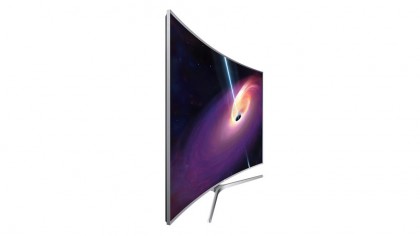TechRadar Verdict
Samsung's bid to bring you High Dynamic Range and UHD technologies for a less eye-watering price than the £6,000 needed for the recently tested UE65JS9500 is mostly a great success.
Pros
- +
Truly next-gen image quality
- +
Much cheaper than 65JS9500
- +
Tizen OS mostly impresses
- +
Upgradable connections and OS
Cons
- -
Backlight clouding issues
- -
Distorted on-screen reflections
- -
Geometery issues off axis
- -
Still not exactly cheap
Why you can trust TechRadar
While other brands are still struggling to get their "normal" 2015 TVs out, Samsung has already launched not one but two groundbreaking models capable of playing High Dynamic Range (HDR) content. What's more, both of these TVs – the previously tested UE65JS9500 and the UE65JS9000 under consideration here, really are extraordinarily good.
HDR, for those of you not familiar with it, delivers images containing expanded luminance and colour ranges, resulting in much more dynamic, punchy picture quality. For HDR, a TV needs to be able to deliver more brightness and a wider colour range than normal LCD TVs, as well as being able to 'parse' HDR sources through its HDMI inputs.

For yes, a full HDR experience depends on a source being mastered with the extra luminance and colour range, as well as a screen to see it on. Which is something of an issue given that at the time of writing there are quite simply no HDR sources available for public consumption.
Netflix is intending to launch a few HDR streams this year, and the Ultra HD Blu-ray format will also support HDR when that emerges (hopefully by Christmas).
But if you buy a UE65JS9500 or UE65JS9000 right now, you'll just have to accept that it's going to be months before you'll be able to experience it firing on all cylinders. Mind you, as we'll see, even a half-cocked UE65JS9000 leaves the competition floundering.
Joining HDR playback on the UE65JS9000's formidable spec sheet is a native UHD (4K) resolution, and a new Nano Crystal colour system capable of producing a claimed 93% of the Digital Cinema Initiative (DCI) colour system usually reserved for professional cinemas.
The screen's capable of delivering up to 1,000 Nits of brightness, versus just 300-500 with typical LCD technology, while the edge LED lighting system is driven by local dimming – where areas of the lighting can have their output controlled individually to boost contrast.
Sign up for breaking news, reviews, opinion, top tech deals, and more.
While this latter feature is always good to find, experience suggests that a locally dimmed edge LED system is no replacement for the flagship UE65JS9500's direct LED system – where the LEDs are mounted directly behind the screen – when it comes to delivering localised brightness, punch and substantially more contrast; two things, of course, which are key to the HDR experience.
I also couldn't help but worry before firing up the UE65JS9000 about the way many edge LED TVs I've tested over the years have tended to suffer with backlight clouding, where areas of dark scenes suffer with unnaturally differing levels of brightness. The potential for such clouding is surely greatly increased by the huge amounts of extra brightness the UE65JS9000 introduces to the TV scene.
Less headline-grabbing picture features of the UE65JS9000 include a powerful video processing system, driven by an Octa-Core processor; a curved screen design (more on this later); and a seriously impressive suite of picture set-up options that include control over all the most important parts of the processing functionality.
One concern with a TV that's as far ahead of the technological curve as the UE65JS9000 is the possibility that its connections and processing may soon become outdated as formats evolve.
But the UE65JS9000 cannily dodges such problems by placing both its connections and brains inside an external box that can simply be replaced with an upgraded version in future years. This is a really great future-proofing touch that gives buyers much-needed extra confidence at this time of seemingly continual TV change.

Wrapping up the UE65JS9000's truly formidable feature list is Samsung's new smart TV system. Powered by the Samsung-owned Tizen engine, this strips back all the clutter and over-bearing menus of Samsung's 2014 TVs in favour of a much cleaner, more streamlined and content-focused onscreen interface, which resembles strikingly closely the groundbreaking webOS system introduced by LG last year.
The Tizen TV OS feels a little unfinished right now – for instance, it can feel slow and unresponsive at times, and will require a future update to add Samsung's previously impressive learning and recommendations system. But it's certainly a big step in the right smart direction.

John has been writing about home entertainment technology for more than two decades - an especially impressive feat considering he still claims to only be 35 years old (yeah, right). In that time he’s reviewed hundreds if not thousands of TVs, projectors and speakers, and spent frankly far too long sitting by himself in a dark room.
